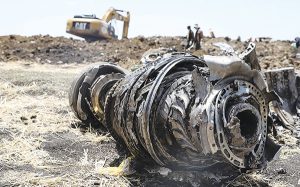Bloomberg
Ethiopian investigators’ report into the Boeing Co. 737 Max crash outside Addis Ababa in 2019 falsely claimed the jetliner had an electrical failure, the US government said, in a highly unusual public rebuttal of the nation’s findings about the fatal accident.
The US National Transportation Safety Board (NTSB) accused the Ethiopian Accident Investigation Bureau (EAIB) of making claims “unsupported by evidence†in conclusions belatedly published late last year.
US investigators said they agreed generally with Ethiopia’s findings that a flawed design in the 737 Max pushed the nose down automatically and was at least part of the cause of the March 10, 2019 crash that killed 157 people. It was the second fatal accident involving the model in a matter of months and led to its worldwide grounding, billions of
dollars in losses to Boeing and multiple investigations.
But the Ethiopians ignored numerous other factors, the NTSB said. In particular, the Ethiopian Airlines Group crew had been told how to counteract a failure of the flawed software known as Maneuvering Characteristics Augmentation System, or MCAS, after a crash off the coast of Indonesia about four months earlier. But they failed to follow the procedure, the NTSB said.
ICAO, or the International Civil Aviation Organisation — an arm of the United Nations — oversees the treaty laying out how countries interact in a plane crash investigation. Homendy said she’d instructed her staff to notify ICAO that they believe the treaty was breached by the Ethiopians.
The dissenting opinion comes several weeks after the crash report was released because Ethiopian officials didn’t share it with the NTSB before announcing their findings. That is required under the treaty governing investigations, the US agency said.
The US previously issued a scathing release on December 27 saying the Ethiopian report contained numerous false statements, ignored critical parts of the cause and repeatedly failed to explore safety issues such as pilot training that might prevent such events in the future.
The French Bureau of Investigation and Analysis for Civil Aviation Safety, which also participated in the investigation, also filed comments with the Ethiopians late last month. Among other things, the French accused the Ethiopians of cutting from its transcript of the cockpit recorder comments made by the young co-pilot showing he was confused.
The Ethiopian report said “unexplained electrical and electronic faults†and “production quality defects†triggered the underlying failure that began pushing down the nose.
 The Gulf Time Newspaper One of the finest business newspapers in the UAE brought to you by our professional writers and editors.
The Gulf Time Newspaper One of the finest business newspapers in the UAE brought to you by our professional writers and editors.
